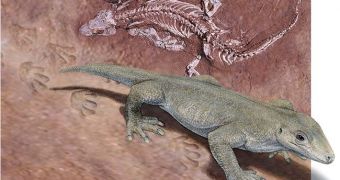290 million years ago we couldn't speak of 'crime scene', but researchers managed to correlate preserved trackways of that age to two species of reptile-like ancient amphibians. Fossils of Diadectes absitus and Orobates pabsti were recently discovered in the Tambach Formation in central Germany.
Close to the fossils and in a similar sediment layer, the researchers discovered well-preserved footprints that matched the fossils, recording their plodding through the soft mud. These are the only known footprints from the Paleozoic Era (540 to 240 million years ago) ("the era of the ancient life"), much before the dinosaurs, to the end of which first land vertebrates emerged.
Due to the exceptional preservation of the Tambach skeletons, the researchers could rethink how the ancient species moved. The group to which the two species belong was the first of land plant eating vertebrates, and left no descendants. "Fossils don't usually include really good feet. It's rare that we get feet with all the toe and wrist and ankle bones [intact].", said study team member David Berman of the Carnegie Museum of Natural History in Pittsburgh.
Orobates is a completely new genus for science. The novel discovery could permit the researchers to partially rebuild the areal of the long-extinct species. "It is not necessary to find the skeleton of a creature at a certain locality to state that this animal has lived there," said Sebastian Voigt, a trackway expert from the Freiberg University of Mining and Technology in Germany.
The discovery also changed old concepts on how some of the first land vertebrates stood and walked. Mammals tend to keep their limbs vertically from the pelvis and shoulder to the ground, under their body, while the reptilian limbs tend to extend away horizontally from the body before turning downward. As the mammalian pattern is more efficient, researchers have always believed it was more evolved. But the new reptile-like amphibians had a mammalian limb pattern.
"We know from the trackways that these animals had their feet planted almost under their body, whereas in textbooks, they give them a sprawling gait as if the limbs are extended out from the body considerably. This just isn't true. You look at the trackway and you see that the footprints are very close to the midline of the body.", Berman said.

 14 DAY TRIAL //
14 DAY TRIAL //